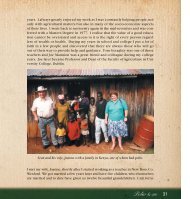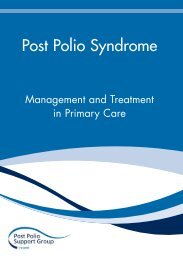Post Polio Syndrome - Management & Treatment in Primary
Post Polio Syndrome - Management & Treatment in Primary
Post Polio Syndrome - Management & Treatment in Primary
You also want an ePaper? Increase the reach of your titles
YUMPU automatically turns print PDFs into web optimized ePapers that Google loves.
26 <strong>Post</strong> <strong>Polio</strong> <strong>Syndrome</strong><br />
Physiotherapy <strong>Management</strong><br />
<strong>Management</strong> of New Weakness<br />
The management of the new weakness <strong>in</strong> the post polio population<br />
with exercise has been controversial. Some early case reports (1915-<br />
1957) suggested that exercise resulted <strong>in</strong> further damage to already<br />
vulnerable motor units and resulted <strong>in</strong> <strong>in</strong>creas<strong>in</strong>g weakness. Other early<br />
studies (1948-1966) found, however, that progressive resistive exercises<br />
produced improvements <strong>in</strong> muscle strength. 36<br />
Recent studies have found that appropriate, carefully monitored,<br />
exercise programmes can be of benefit to prior polio patients. 16, 37-41 One<br />
randomised controlled trial found an improvement <strong>in</strong> voluntary strength<br />
of the thumb muscles after 12 weeks of moderate <strong>in</strong>tensity tra<strong>in</strong><strong>in</strong>g 3<br />
times per week. Moreover, it was found that tra<strong>in</strong><strong>in</strong>g did not impact<br />
on the viability of the motor neurons of the tra<strong>in</strong>ed muscles. 38 A study<br />
<strong>in</strong>vestigat<strong>in</strong>g a higher <strong>in</strong>tensity programme, us<strong>in</strong>g maximal isok<strong>in</strong>etic<br />
and isometric exercise on a Cybex resulted <strong>in</strong> an <strong>in</strong>crease <strong>in</strong> Quadriceps<br />
muscle strength and some changes <strong>in</strong> fibre size. 40 Two other studies have<br />
exam<strong>in</strong>ed the effect of moderate <strong>in</strong>tensity exercise, 39, 41 and found overall<br />
<strong>in</strong>creases <strong>in</strong> muscle strength but each of the studies described some<br />
<strong>in</strong>dividuals who showed a decrease <strong>in</strong> strength and/or <strong>in</strong>creased pa<strong>in</strong>.<br />
It is recommended that <strong>in</strong>dividuals should learn to monitor and manage<br />
weakness and fatigue before commenc<strong>in</strong>g an exercise programme and<br />
that ‘additional exercise should be completely avoided <strong>in</strong> patients who<br />
are too weak and fatigued and are already spend<strong>in</strong>g most of their energy<br />
simply perform<strong>in</strong>g activities of daily liv<strong>in</strong>g’. 16 Furthermore, muscle<br />
overuse, manifested as an ach<strong>in</strong>g on exertion should be avoided and<br />
regarded as a warn<strong>in</strong>g sign. Recommendations for muscle strengthen<strong>in</strong>g<br />
are summarised below <strong>in</strong> Box 6.<br />
box 6: guidel<strong>in</strong>es on the use oF strengthen<strong>in</strong>g exerCises<br />
Prior <strong>Polio</strong> subjects can <strong>in</strong>crease muscle strength with appropriate <strong>in</strong>dividualised<br />
exercise programmes<br />
An <strong>in</strong>dividual prescribed an exercise programme should be monitored for<br />
deterioration <strong>in</strong> muscle strength, <strong>in</strong>creased pa<strong>in</strong> or <strong>in</strong>creased fatigue<br />
Individuals should learn to monitor and manage weakness and fatigue prior to<br />
commenc<strong>in</strong>g an exercise programme<br />
Muscle overuse, manifested as an ach<strong>in</strong>g on exertion should be avoided<br />
PPS Mngt and Treat.<strong>in</strong>db 26 02/07/2007 16:07:51





